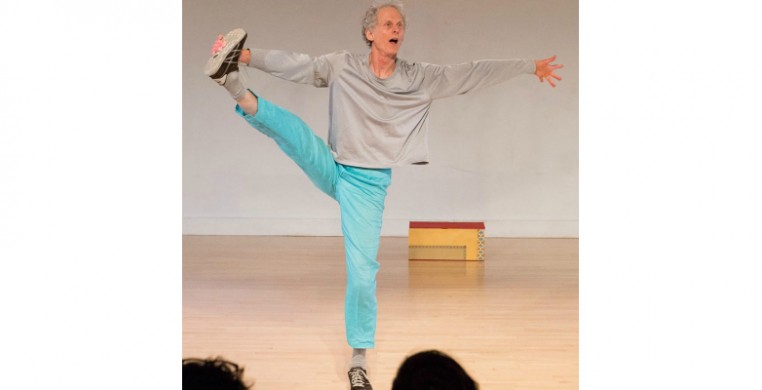It’s been nearly two decades since Bob Eisen moved to New York. He’s a tall drink of water with smiling eyes and a cheeky smirk, one of three founders who, in 1978, formed a new dance space called Links Hall.
These days Eisen splits his time between Manhattan and St. Petersburg, Russia, but returns to Chicago every so often to visit his old stomping grounds. Here, he’s among friends.
Case in point: to celebrate its 40th anniversary season a Wednesday one-off of new works filled Links Hall’s white space on Oct. 3, with guests squeezing into the experimental performance space Eisen helped create. And per usual, Bob Eisen and Links Hall go together like peanut butter and jelly: messy and delicious.
To start the evening, titled “One off, off one, again,” Eisen and Joanne Barrett came out together in his signature bright pants and sneakers. It’s fitting that it’s a Wednesday – the two used to perform together as part of a Wednesday night summer series at Links Hall in 1990.
Eisen and Barrett come off as delightfully random, but as a choreographer, Eisen has a pretty set list of quips and tricks. Ever present in a Bob Eisen dance, including this one and the evening’s closer – a quartet set on dancers from Same Planet Performance Project – includes some variation of sweeping fan kicks with an arm drawing an arch overhead, silly and lovable gestures, walking in a circle like water funneling down a drain, a foot-to-hand grab and plenty of handstands leaned against Links Hall’s signature white walls.
At age 71, these habits are now simply charming, and give today’s dance audiences a window into Chicago’s particular brand of postmodern dance, developed in dance spaces such as Links and MoMing in the ‘70s and ‘80s.
The evolution of this aesthetic might be seen in a choreographer like Paige Caldarella, who shared a new work for dancers Jess Duffy and Chloe Grace Michels as part of “One off, off one, again.” A former Cunningham dancer, Caldarella takes cues from Merce in her use of clean, crisp lines, and a challenging manipulation of ballet technique which shines on Duffy and Michels, two of our city’s best freelance dancers. But this untitled work, like her others, is infused with a bit more meaning – a soulful underbelly that’s missing in much of Merce Cunningham’s work. I say this not as a qualitative dig toward Cunningham, but as a matter of observation. And it's something Caldarella shares with the previous generation of Chicago postmodernists such as Eisen.
The duet, performed in pedestrian shorts and shirts, could be thought of as an exercise in “getting on your leg,” as the oft-used correction goes. Its mood is pricked and placed, with much time spent balancing in releve or turning and stopping on a single leg. But there is a wonderful sense of fall and recover – or maybe a better way to phrase it is “react and respond” – in the relationship between these two dancers. The score, which sounds like packing tape being stretched to lay across a cardboard moving box, adds to this context. One thinks of clichés such as “sticking the landing,” as Caldarella asks the women to end each phrase in impossibly hard positions – another thing she shares with her former boss, Merce.
Laurie Van Wieren came second on this shared bill of five pieces, performing a solo that perfectly aligns with the jovial idiosyncrasies of Eisen’s curatorial acumen. Hailing from Minneapolis, Van Wieren blends choppy, breathy, sometimes nonsensical text with pedestrian patterns and, occasionally, a glimmer of Dance, capital D. A rather maniacal figure, Van Wieren seems to be talking to herself, or maybe to a collection of alter egos or invisible friends. Her eyes, glowing behind wide-rimmed black glasses, follow a distracting house fly that’s joined us for the evening, or look doubtingly at us, her mutterings a mixture of profundity and lunacy.
Beau O’Reilly capped the evening with a spoken word piece which essentially imagines the reincarnation of Judy Garland. O’Reilly, with a silk ascott, long gray mane and piercing eyes, tells a fantastical tale of how the legend herself floated from her grave to arrive at some old haunts like the Uptown Theater and a little known space at Clark and Sheffield – the original site of Links Hall – left to wonder whatever happened to the “showbiz” she once knew.


